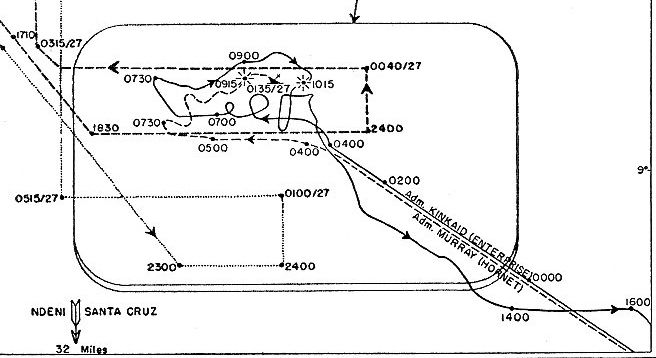Back to the location and DIRECTIONS that USN forces were at during the Battle of Santa Cruz and specifically which course USS HORNET was on at different times during the battle, here is the map provided in Samuel Morrison's book.
This Image shows the operating area of the USN forces during the Battle, giving orientation of the battle area and general wind speed direction. Note that the carriers had to turn to the southeast to launch and recover aircraft.

A close-up of the operation area of the carriers during the battle showing their relative movements. Notice how many times HORNET changed course with at least two swings to the SE to launch aircraft.

From USS JUNEAU's War Diary 26 October 1942 (Note that Morrison's times are one hour different than JUNEAU's times);
3. Chronological log of Battle. (Kept by quartermasters specially detailed for this duty. Times are believed to be exact to the nearest minute).
TIME - (-12)
0756 - Ship went to general quarters
0800 - Ship's position Lat. 8-37 S., Long. 166-40 E. Base course 270 degrees, speed 23 knots.
0810 - NORTHHAMPTON radar contact reported bogey aircraft bearing 200 degrees (T), 28 miles.
0812 - Changed base course on signal to 330 degrees (T), speed 27 knots.
0831 - HORNET launched planes. Course approximately 120 degrees. Maneuvered to maintain station. 0845 - Resumed base course 330 degrees (T).
0857 - HORNET launched planes. Maneuvered to maintain station, to resumed base course 330 degrees (T). 0929 - Received signal to "Go to General Quarters" from C.T.F.17.
0942 - Planes report enemy dive bombers to port of ENTERPRISE. Intercepted message from ENTERPRISE to HORNET over Combat Air Patrol voice circuit for HORNET to launch all aircraft.
0943 - HORNET launched planes. Increased speed to 30 knots. Resumed to base course of 330 degrees (T).
0948 - HORNET directs lookout for Hawks and Zeros. NORTHHAMPTON reports radar contact of bogey aircraft bearing 270 degrees (T), 35 miles.
0956 - Sighted smoke on water on port beam. Plane evidently shot down.
0958 - HORNET reports radar contact on bogey aircraft bearing 270 degrees (T), 25 miles.
1000 - Ships position in Lat. 8-31 S., Long. 168-45 E. Ship's head 110 degrees (T), speed 29 knots. Search planes report 9 enemy dive bombers on course southeast.
1001 - Changed course to 080 degrees (T).
1004 - Our Combat Patrol reported enemy dive bombers at 17,000 feet.
1005 - Fighters report contacting enemy dive bombers.
1006 - A destroyer reports planes coming in high.
1009 - Sighted smoke on water bearing 225 degrees (T). NORTHAMPTON reports planes bearing 200 degrees (T), 28 miles.
1010 - Dive bombers attack developes with HORNET as target. Close miss on carrier. JUNEAU opens fire with 5" and machine gun batteries. Ship's head 065 degrees (T). Bearing of HORNET about 265 degrees (T), 2000 yards. Plane shot down. Dive bombers at 7,000 feet.
1011 - Dive bombing attack continuing on carrier. Plane shot down ahead of carrier.
1012 - HORNET hit by bomb aft. Heavy sheet of flame visible. HORNET on starboard quarter of JUNEAU.
1013 - Plane shot down.
1014 - Two (2) planes shot down.
1015 - Two (2) planes shot down. One crashing off JUNEAU starboard bow about 200 yards. Torpedo plane attack developed. Three (3) torpedo planes launched torpedos off JUNEAU starboard bow. HORNET on fire.



